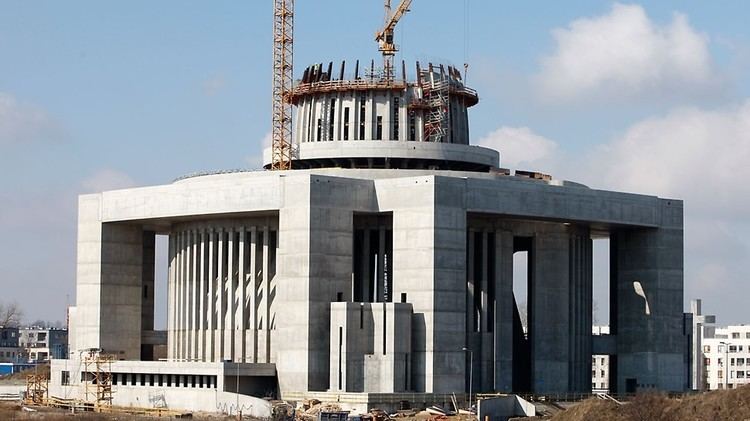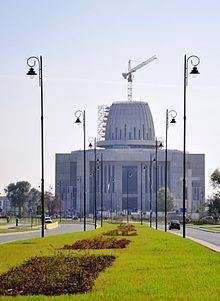Material Concrete | Architectural type Church Height 75 m Year consecrated 2016 | |
 | ||
Architects Lech Szymborski, Wojciech Szymborski Similar | ||
The Temple of Divine Providence (Polish: Świątynia Opatrzności Bożej), in southern Warsaw's Wilanów district, is one of the most important Roman Catholic buildings in Poland. The story of its construction began in the 18th century The Temple is meant to be a national and religious symbol for Poland. The Divine Providence complex comprises a Church of Divine Providence, a Museum of John Paul II and Primate Wyszyński, and a Pantheon of Great Poles.
Contents
- First Polish Republic
- Second Polish Republic
- Third Polish Republic
- Museum of John Paul II and Cardinal Wyszyski
- Pantheon of great Poles
- References

The Center of Divine Providence commemorates Poland as a country with a Roman Catholic majority and links providential events in Poland's history over the past 200 years with their putative divine inspiration: the Constitution of May 3, 1791; the 1918 rebirth of independent Poland; the 1920 "Miracle at the Vistula"; the August 1980 founding of the Solidarity movement; the next resumption of independence, in 1989; and the pastoral ministry of Stefan Wyszynski and the pontificate of Pope John Paul II. The Center is a votive church for 1,000 years of Poland's Christianity.

First Polish Republic
The idea of constructing a National Temple of Divine Providence goes back to the reign of Stanisław August Poniatowski. Two days after the Four-Year Sejm had passed the 3 May Constitution, on 5 May 1791, the members and the king made a commitment of thanksgiving to erect a church "ex voto of all estates ... dedicated to the highest Providence." It was to be an expression of thanksgiving to "the Highest Ruler of the fate of nations" for the adoption of the constitution.

The celebration of laying the cornerstone of the planned shrine in Ujazdów was held on the first anniversary of the constitution. King Stanisław August and the last Primate of the Polish-Lithuanian Commonwealth, Archbishop Michał Jerzy Poniatowski, began the construction of the shrine. The monarch also accepted the design of his royal architect Jakub Kubicki. The Temple was to be built in the classicist style on the plan of a Greek cross. However, the Russian army attacked Poland, making construction impossible. Three years later Poland disappeared from the maps of Europe. Only a small ruined chapel, in the Botanical Garden in Agrykola (Ujazdów), survived.
Second Polish Republic
After Poland regained independence in 1918 the Sejm of the restored Second Polish Republic passed an act to build the shrine on 17 March 1921. The Parliament decided that the state would cover the cost of the construction, which was to be 15 million old zlotys. The budget was also to finance a perpetual scholarship to order Masses celebrated in the intention of the Homeland and for the souls of all Poles who died for the country. However, financial difficulties and inflation did not allow the young state to bear such costs. The Committee on Commemorating Marshal Józef Piłsudski, created after his death, chaired by President Ignacy Mościcki, decided to carry out the project. The Shrine of Divine Providence was to be built in the fields of Mokotów. The Committee announced a tender and chose Bohdan Pniewski's design: a building of the constructivist style with a tower that would resemble the skyscrapers of New York. However, the start date was constantly postponed; finally, it was settled in 1939, the year in which Germany and the Soviet Union invaded Poland, starting World War II.
Third Polish Republic
The project could not be realised during the war. The post-war communist Polish People's Republic did not continue with the project. Following the fall of communism in 1989, the Primate of Poland Cardinal Jozef Glemp revived the idea of the shrine in the late 1990s. The Sejm on 23 October 1998 adopted, by a decisive majority, an act to construct the National Temple of Divine Providence. The resolution said that "the Sejm of the Third Republic of Poland thinks that the vows the Polish nation made 200 years ago should be fulfilled" and the shrine would be "a votive church of the nation for the Constitution of 3 May, the regained independence in 1989, for twenty years of John Paul II's pontificate and two thousand years of Christianity."
John Paul II also supported the construction of the Temple. In his pilgrimage to Poland in 1999, during the celebration in Pilsudski Square, he blessed the cornerstone, which was embedded at the position of the future altar. He said, "May this shrine become a place of special thanksgiving for freedom of the Homeland. I pray that no painful experience would disturb this thanksgiving for which we have waited 200 years." The Pope prayed for the construction and provided financial help. The shrine is being constructed in Wilanów, the end of the historic Royal Route.
In January 2002, the Primate chose the final design of the shrine by the architects' team directed by Wojciech and Lech Szymborski, with an estimated cost of around 40 million euros. This sum was met to a large extent through private donations and co-financed by a state budget. The building is based on an 84 m x 84 m base area in the form of a Greek cross – a cross with four equal length arms, with four gates, a dome and a cross. The building will has an overall height of around 75 metres. 26 columns are arranged in a circle to form the nave of the church which has a 68 m diameter. In November 2002, Cardinal Glemp began the construction by making a symbolic gesture; he dug with a spade next to the cornerstone.
The temple was officially opened on Poland's Independence Day, 11 November 2016, by Cardinal Kazimierz Nycz, the archbishop of Warsaw. The ceremony was attended by President Andrzej Duda, Prime Minister Beata Szydło, speakers of both houses of parliament and other politicians. The official opening does not mean that all contrcution work is complete, as some finishing touches are still needed.
Museum of John Paul II and Cardinal Wyszyński
The complex of Divine Providence will house a multi-media museum dedicated to Pope John Paul II and to Cardinal Stefan Wyszyński. The museum will be placed in the non-sacred part of Temple of Divine Providence in Warsaw. The centre for documenting the Polish Pope's pontificate and the pastoral ministry of Cardinal Stefan Wyszyński will be in the modern museum. The cultural centre will catalogue the collections and preserve them as well as conducting research. The museum will show the activities of John Paul II and Cardinal Stefan Wyszyński and will show the close relationship between the two Poles. Archbishop Kazimierz Nycz would like this multi-media museum to follow the model of the Museum of the Warsaw Uprising, that draws many young people. The Centre of Divine Providence will show the substantial contribution of the Church to the history of the Polish Nation.
Pantheon of great Poles
The Pantheon of Great Poles is an underground part of the Temple of Divine Providence in Warsaw. The Pantheon is a funeral site for important Poles. A symbolic tomb for Pope John Paul II (a replica of his tomb in St. Peter's Basilica) is placed in the Pantheon.
Inside the crypt for the honoured are buried:
